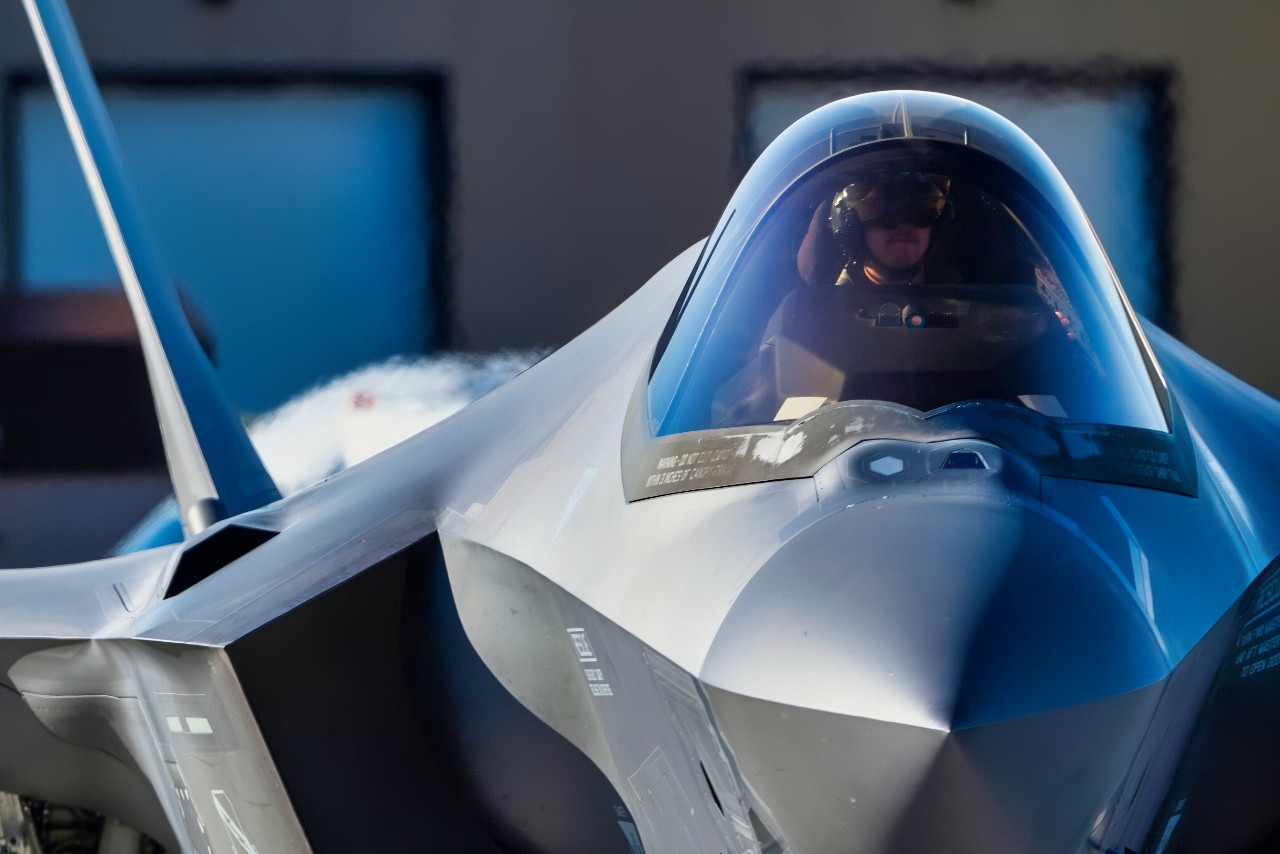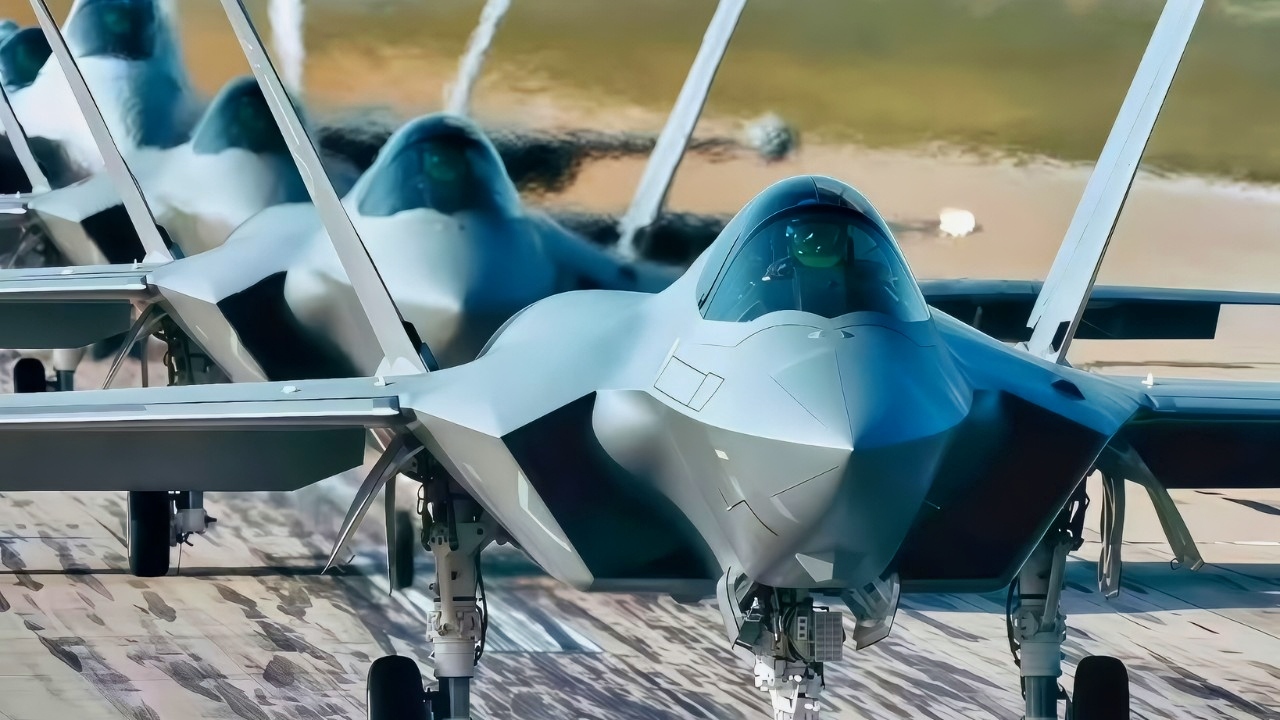Key Points and Summary – China is touting the J-35’s stealth as “palm-sized,” hinting it’s approaching F-35 levels of low observability.
-Even if that boast is half true, it’s only part of the fight. Beijing is racing ahead on carriers, drones, and stealth designs—and may field J-35s by the dozens each year.
-The catch? Pilots. The PLAAF produces far fewer aviators than the U.S., has less access to high-end training ranges, and lacks real combat experience.
-Stealthy airframes matter, but sustained proficiency, tactics, and reps under pressure decide outcomes.
-For now, China’s jets are catching up faster than its pilot pipeline.
J-35 Catching Up To American Stealth – But Has One Major Disadvantage
Chinese state broadcaster CCTV has continued its recent trend of publishing remarkable new details about upcoming Chinese military systems – this time focusing on the J-35 carrier-based fighter. According to the broadcaster, the J-35’s stealth capabilities are nearly as advanced as those of the United States’ famed F-35 stealth fighter jet.
News that the upcoming aircraft’s radar cross-section (RCS) is smaller than a human palm, however, doesn’t tell the whole story.
What China Claims
In the broadcast, the aircraft’s radar cross-section was described as being smaller than a human palm – a comparison that, if taken literally, would place the J-35’s radar visibility somewhere between 10 and 100 square centimeters.
That level of detectability would represent a significant advance over earlier Chinese designs, edging the jet into the same low-observable class as the F-35 – albeit still behind the U.S. benchmark for stealth, the F-22 Raptor, which is often described as having an RCS comparable to that of a marble.
The stealth breakthrough was attributed to a combination of refined airframe shaping and the use of new metamaterials – meaning materials specially engineered to control how electromagnetic waves interact with it.

U.S. Air Force Capt. Nick “Laz” Le Tourneau, F-22 Raptor Aerial Demonstration Team commander, performs an aerial maneuver during the Cocoa Beach air show in Florida, July 12, 2025. The F-22 Aerial Demonstration Team highlights cutting-edge airpower, precision, skill, all while reinforcing public confidence in the Air Force’s ability to protect and defend. (U.S. Air Force photo by Staff Sgt. Lauren Cobin)
Those metamaterials, reports suggest, were developed at home. And by invoking proprietary technology, Beijing appears eager to present the J-35 not just as an evolutionary step from its earlier J-31 concept, but as proof that Chinese aerospace firms are closing the gap in terms of advanced stealth design.
In practical terms, the claim puts the J-35’s stealth signature just behind the F-35’s often-cited golf-ball-sized RCS.
If even partly accurate, that would mean the fighter could evade most conventional radar systems until operating at short ranges. But those figures remain unverified, and selective disclosures of performance data have long been a common tactic used by Beijing.
Regardless, the message is clear that China wants the world to know that the J-35 is the only other carrier-capable stealth jet, besides the F-35. The platform has already been tested from the Type 003 Fujian aircraft carrier’s electromagnetic catapults and is intended to complement the larger J-20.
Does It Matter?
In one sense, yes – China’s J-35 coming close to the F-35’s stealth performance is significant. Beijing’s claims reflect the frankly shocking pace of Chinese military modernization in recent years, and the stealth fighter is only one piece of a much bigger puzzle.
Alongside the J-35, China is advancing a wide portfolio of next-generation systems: the Type 003 Fujian, its first electromagnetic catapult-equipped carrier; the anticipated Type 004, which will rival the U.S. Navy’s Ford-class in size; and a growing number of stealth aircraft designs across both the air force and navy.
Add to that loyal-wingman drone and uncrewed combat air vehicles, and the picture becomes clearer – China may not have matched U.S. capability just yet, but it is moving aggressively to close the gap.
The real concern for Washington is not just qualitative parity, however, but the sheer numbers of aircraft Beijing intends to field.
While formal production goals have not been revealed, recent state-aligned commentary has hinted at the possibility of J-35s being produced in their dozens every year, enough to fill multiple carrier air wings within a decade.

J-20 Stealth Fighter. Image Credit: PLAAF.
Combined with the continued serial production of the J-20 and early indications that work on sixth-generation platforms is well underway, the trajectory suggests that China aims to field large numbers of advanced equipment.
Even if Chinese stealth remains a generation behind – and that’s a big if – fielding hundreds of low-observable fighters across both the PLAAF and PLAN could totally reshape the regional balance.
Beyond J-35: Does China Have the Pilots?
Even if China succeeds in fielding hundreds of new stealth aircraft, the question remains whether it can produce the pilots to fly them.
Pilot training has long been a bottleneck for the PLAAF, which currently graduates around 400 new pilots per year. The U.S. Air Force, by comparison, trains roughly 1,350 annually, despite falling short of its own targets. That production gap is significant because Beijing may produce aircraft at scale.
Still, without increasing the number of qualified aviators available to fly them, many of those jets might ultimately be underutilized.
China is also continuing to reform its training pipeline. Until recently, the PLAAF’s process took about four years from entry to assignment, with pilots completing transition training inside combat units rather than dedicated academics. Reforms are currently underway to streamline that system and centralize instruction.
By contrast, U.S. aviators benefit from advanced training ranges, such as Nellis Air Force Base’s Red Flag and the Joint Pacific Alaska Range Complex, where live and virtual systems replicate contested environments.
Just as important, American pilots also bring decades of combat experience from Iraq, Afghanistan, and Syria – hard lessons that Chinese aviators simply cannot match.

An F-35A Lightning II fighter jet, a single seat, single engine, all-weather stealth multirole fighter aircraft, assigned to the 466 fighter squadron prepares to taxi across the flightline at Hill Air Force Base, Utah, Oct. 5, 2024.
Stealth, therefore, is only part of the equation.
China may be catching up in airframes, but without equally advanced pilot training, its numerical advantage and rapidly advancing stealth technologies risk being blunted by more experienced American aviators.
About the Author:
Jack Buckby is a British author, counter-extremism researcher, and journalist based in New York who writes frequently for National Security Journal. Reporting on the U.K., Europe, and the U.S., he works to analyze and understand left-wing and right-wing radicalization, and reports on Western governments’ approaches to the pressing issues of today. His books and research papers explore these themes and propose pragmatic solutions to our increasingly polarized society. His latest book is The Truth Teller: RFK Jr. and the Case for a Post-Partisan Presidency.
More Military
X-43A: It Could Hit Mach 9.6 and NASA Walked Away
Trump Wants a U.S. Navy Battleship Comeback: Reality Has Other Ideas
Russia’s Su-34 ‘Fighter Bomber’ Is Getting Blasted Out of the Skies Above Ukraine
Boeing X-32 vs. YF-23 Black Widow II Stealth Fighter: Who Wins Summed Up in 4 Words










